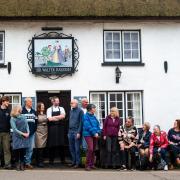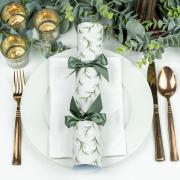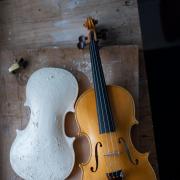Unwrapping the legends of why we decorate our homes with 4 types of festive greenery

“Deck the hall with boughs of holly...” I’m singing it to myself as I write. With the commendable shift away from plastic, more of us are turning to the natural world to decorate our homes for Christmas, with the added advantage that it’s compostable afterwards.
The most frequently selected plants for seasonal embellishment in the UK are four traditional stalwarts from a forest of greenery: real Christmas trees (traditionally Norway spruce), holly, ivy and mistletoe. But why?
Pre-Christian pagan customs often involved the gathering of greenery to mark the winter solstice, evergreens being symbolic of renewal and continuity of life at a raw time of year. Later these practices were incorporated into Christian customs to retain a link to the old ways, easing the transition.
My discovery of an ancient tome on plants encouraged further investigation. The folklore is vast, geographically varied and could fill several books; here are some seasonal snippets.

Holly
European folklore associated holly with the gods of thunder and it was frequently planted near buildings as it was believed to protect against lightning strikes. Remarkably, research has shown this to be more than mere myth as the spines on the leaves can act as tiny electrical conductors.

Felling a holly tree was thought unlucky, but using parts of the tree as decoration was quite acceptable and considered protective.
In pre-Christian times it was brought indoors during the dark winter months in an effort to ward off evil spirits – the Druids believed it to have magical powers. Celtic mythology associated holly with the winter solstice; for the Romans holly was a symbol of Saturnalia, their midwinter festival. It was regarded by many as a guard against witchery and goblins.
As Christianity spread holly was adopted as a symbol of the new faith and before the Victorian era it was referred to in some rural areas as ‘the Christmas tree’. It’s easy to see how holly’s prickly leaves could be regarded as symbolic of Christ’s crown of thorns, with the berries representing drops of blood.
Ivy
Ivy was regarded as the feminine counterpart to the masculine holly and the two plants are frequently entwined in traditional carols.
Scrambling up walls and over trees, ivy is tenacious, its berries providing great winter fodder for many birds. Its leaves, together with those of holly, are one of the preferred foodstuffs of the caterpillar of the delightful holly blue butterfly. In the distant past, ivy’s ability to swamp grape vines convinced herbalists that the berries were an antidote to excess alcohol.
Ivy’s use for interior decor stems from the old superstition that goblins could be at their most tricksy at Christmas, so to safeguard the home against their evil intentions ivy, which was also believed to have magical powers, would be hung on doors, fireplaces and anywhere that miscreants might find ingress into the house.
Mistletoe
This plant is partly parasitic, living off a host tree. These hosts are often apple or hawthorn, though many others can be colonised. Mistletoe was long regarded as powerfully magical, a plant that lives high above ground with, seemingly, no source of sustenance, though we now know that it takes nutrient from its host and also generates some of its own through photosynthesis. The white berries are borne during winter.
Pliny the Elder, who lived in the first century, recorded that Druids cut mistletoe with a golden sickle for use in sacred rites. As it was cut, it was caught in a white robe, as contact with the ground would drain away its magical powers.
Mainland Europeans regarded mistletoe as a plant of peace and good fortune, and that was the case in Britain until the Christmas tradition of kissing beneath it became more dominant.
The kissing is, essentially, a custom associated with fertility. Norse mythology suggested that it was bad luck to refuse a kiss beneath mistletoe. At one time, any man permitted to steal a kiss had to pluck a berry from the bunch hanging above his head – once all the berries had been plucked no more kissing was permitted!
Christmas Trees
During the reign of Queen Victoria, the tradition of having a tree indoors for Christmas arrived in Britain, introduced from Prince Albert’s native Germany in 1841. But the custom goes back much further and has a Devon connection.
In the year 680AD, St Boniface, as he later became known, was born in Crediton. He grew up to become a priest with a missionary zeal to travel and it was during his time in Germany that his association with what was to become the Christmas tree began.
During the 8th century paganism in Germany was rife. A site of particular significance was Thor’s Oak at Geismar. At this tree human sacrifice reputedly took place and Boniface, in an attempt to thwart the heathen during their mid-winter ritual, felled the oak. Legend says that the onlookers, astonished that the destroyer of their tree wasn’t instantly struck down himself, were won over by Boniface’s faith and began to convert to Christianity.
Amongst the shattered debris of Thor’s Oak, Boniface found a tiny fir tree sapling. This he regarded as symbolic of the new faith he was teaching, saying: “This little tree shall be your holy tree tonight”.
Thus the pagan ritual was converted into a Christian one and the first Christmas tree was born, its triangular shape a reminder, it was considered, of the Trinity.
So, as you arrange sprigs of holly and ivy around your home, decorate your Christmas tree or sneak a quick peck underneath the mistletoe, you will be upholding traditions that link past paganism to the present day. Much-loved plants that have their roots in a dark and distant past. Happy Christmas!



























